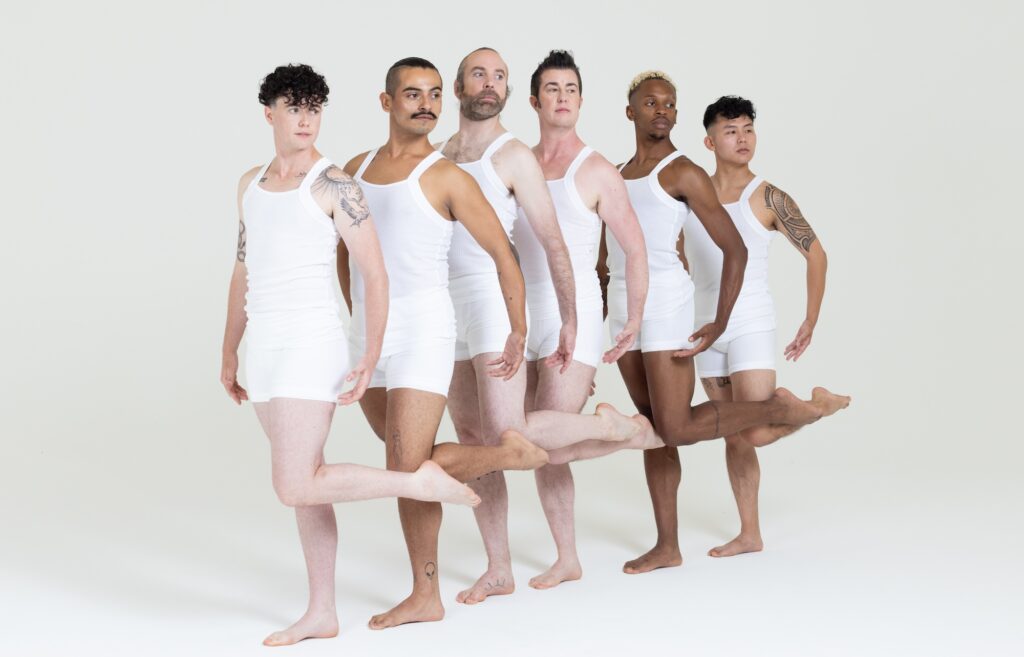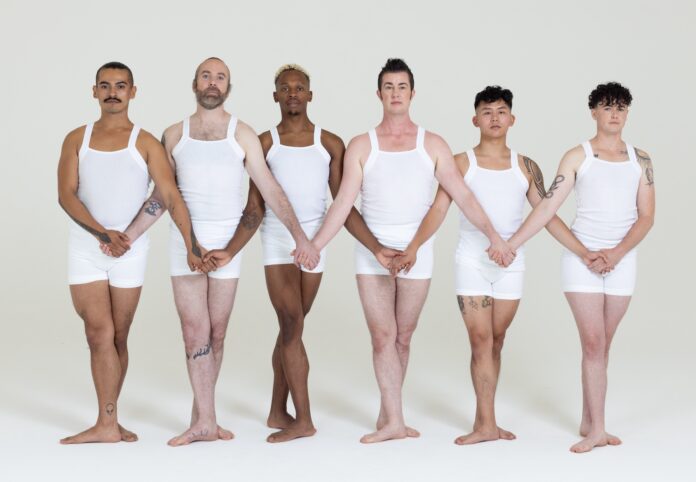I began a recent conversation with Best of the Bay-winning choreographer Sean Dorsey by asking him, “What question do you get asked all the time?” He answered that he is always asked how he got into dance, adding “While I love talking about my lifelong passion and my deep visceral joy of dance, I’ve noticed very few of my cisgender peers get asked this question.” He goes on, “If I were to answer your question 20 years ago, the question I got all the time then was ‘when did you know you were transgendered and how did that overlap with your dance journey?’ We don’t ask heterosexual dancers when they knew they were heterosexual… But thank goodness that single-minded fascination has shifted.”
Dorsey muses that he wishes interviewers asked him about his creative process, what inspires him, and about touring, what has changed in the 20 years since his company set out on the road. “We’ve toured to over 35 cities, which is pretty unique for an artist whose work is transcentric,” he tells me, adding, “The better question is, ‘How did you make a life in modern dance?’”
Long recognized as the first acclaimed transgender modern dance choreographer in the US, Dorsey has made his life in modern dance by making original works for his eponymous dance company, teaching his explicitly trans-positive pedagogy, and performing around the country and internationally. Sean Dorsey Dance (SDD) marks its 20th Anniversary Season with a celebratory three-night run at Z Space in San Francisco, September 19-21 (more info here). The company will perform a powerful retrospective program featuring Lou (2009), based on the lifelong diaries of pioneering trans activist Lou Sullivan, and excerpts from The Missing Generation (2015) and The Secret History of Love (2012), both based on oral histories Dorsey recorded with LGBTQI+ elders across the US.
“This Home Season is about legacy, about sharing our history, about uplifting stunning beauty, heartache, resilience, and love, especially at this brutal moment in America,” says Dorsey. “My work is embodied, joyous, righteous resistance to the massive, national anti-transgender backlash my community is enduring right now,” he adds. “There are 643 active anti-trans bills in 43 states this year alone. Our existence, our rights and our freedom of expression are under attack. This is an incredibly important time to uplift trans and queer history and artistry.”
How, then, has Dorsey made a life in modern dance? By trailblazing.The 20 year timeline for Sean Dorsey Dance is filled with significant milestones: first European tour in 2014, the first openly transgendered choreographer on the cover of Dance Magazine in 2019, a 2024 Emmy Award for his choreography and collaboration on KQED‐PBS short film, Transgender Dancer Sean Dorsey Dreams of Limitless Future for Transgender and Queer People, as well as numerous awards, tours, and fellowships along the way.
The upcoming season features excerpts from a trilogy of SDD works that lift up previously buried, censored or forgotten trans and queer history that Dorsey created between 2009 and 2015. He says,“I wanted to ask: what happens to those stories, those lives that slip between the pages of recorded history and family albums? How do we uncover and reclaim the important stories of trans and queer people that history passes by? I worked with diaries, archives and oral histories as powerful ways to uncover and share our history.”
Dorsey’s voice provides the narration for the Lou soundscore in which Dorsey reads excerpts from Sullivan’s diary entries. When Dorsey recorded the original score in 2009, he had been living openly as transgender for more than a decade, without taking testosterone. Like Lou Sullivan, however, Dorsey later decided to start taking testosterone and so this year, he re-recorded the entire soundscore in his current “post-T” voice.
“It’s incredibly moving to be re-recording my own poetry-narration for the score, as well as these hundreds of diary entries Lou wrote, in my current voice,” Dorsey shares, “Audiences actually still will hear my old voice during the early part of Lou’s journey where he is aching for his body to align more with his spirit. I think this change is a powerful, powerful addition to the show.”
Dorsey’s creative process is long, spending sometimes two to three years researching and writing before bringing in one of his longtime musical composers Alex Kelly or Anomie Belle, to develop the sound for his narrative-musical scores. By the time he enters the studio, Dorsey is prepared with a clear outline for a dance, often enhanced by his imaginings of specific movement and the dancers who will do it.
Asked how he casts his work, Dorsey tells me that he has never held an audition, but rather connects with dancers one-on-one. “The first thing I consider is kindness, open and warm communication, tremendous capacity for compassion, and maturity of performance presence,” he explains. Like most choreographers, he’s drawn to exceptional physical training and says that within his five-member company, the dancers have eclectic dance backgrounds, referring to the collective’s varied dance vocabularies as “a glorious juicy toolbox.”
He tells me “My work requires physical technical capacity,a maturity of performance presence and a high level of trust. I’m writing and choreographing everything, but we’re all generating movement material together. All of our unique bodies and experiences are feeding this collaboration and the work that ends up onstage. I need to create a safe space where we can all take risks and hold each other with love and humor. There is a lot of laughter in our rehearsals.”

As part of that safety, Dorsey provides a company class (taught by his dancers who are paid) at the beginning of every rehearsal, includes injury prevention conditioning in company warm-ups, and retains the services of a physical therapist specializing with dancers who is available to his company members when they are injured or if they simply need a wellness check in. Becca Dean who debuts their first season with SDD this month, says “From first meeting Sean, I felt his dedication to creating a safe and equitable container for the creative expression of vulnerable content.”
Dancer Brandon Graham tells me, “Working with Sean in comparison to other choreographers has been so eye opening, to say the least. He is very aware of the political climate of the world and the changes that the dance community want and advocate for. Sean being so nuanced and intersectional, he is aware of others’ struggles and challenges. As someone that is queer, black and disabled I crave to be seen as my full self and not only pieces of me that choreographers want. Sean is sensitive and helpful with the things we may be going through in and out of the studio and I feel safe in his presence knowing I can come to rehearsal as just me, not a pawn or as someone that is replaceable.”
Dean adds, “As a trans dancer, I’ve never worked for a choreographer who is also trans, so this is some T4T magic! “ Referring to a moment in Lou, Dean goes on, “I feel it in the duet Sean and I do together, in which I’m learning the part he did in 2009 shortly after his top surgery. There’s a point where I stand alone after a solo, look up and see Sean emerge behind me, as a living ancestor who has carved a path for me. At this moment, I imagine most of our trans ancestors, like Lou Sullivan, fading too soon into memory behind Sean, not living long enough to stand with us in the flesh. In Lou, we are writing an intergenerational legacy of queer and trans joy. I hope this project gives us all some resilience to make sure it’s a long story we all get to tell together in the flesh, in our flesh, as we like it.”
Dorsey’s advocacy does not stop with his own company members. Written into the company’s contracts with performance and teaching venues is the requirement that all-gender restrooms be provided for performers, audiences and students. The Joyce Theater in New York City chose to change one lobby bathroom to be all-gender permanently, and converted all backstage bathrooms to be all-gender, and other presenters have followed suit. A not insignificant shift, all-gender bathrooms is a way of acknowledging and welcoming trans and non-binary patrons and artists and it’s another example of how Dorsey’s life in dance is marked by demanding recognition both on and off the stage.
That’s 20 years of artmaking, family building, and advocacy. Twenty years of fierce dreaming and hard work. I ask Dorsey: what holds him up? Who supports him? He tells me about his partner of more than 22 years, trans folk-punk singer-songwriter and artistic director of the SF Transgender Film Festival Shawna Virago. “I have a brilliant, beautiful, amazing, life partner who is also a trans artist. We’re huge supporters for each other as sounding boards, editors, cheerleaders and comrades in our activism. She is my foundation and my rock and my dream come true.”
He goes on: “And my company family. My brilliant dancer-collaborators Becca, Brandon, David, Héctor, and Nol.” He continues, naming longtime lighting designer Clyde Sheets and technical director Emily Paulson. He doesn’t stop there, listing presenter partners at various institutions including 7 Stages Atlanta, Dance Place in Washington DC, and Queer Cultural Center in San Francisco, among others. “I have all these people who are genuinely friends and family,” he says. ”They have taken up the gauntlet of intersectional trans equity as being part of their curatorial work. It makes it possible to have trans and queer communities in different cities, beyond the Bay Area. These are people who have my back and genuinely care about my well being and artistry. I feel held by all these people.“
Sounds like a pretty good life.
Sean Dorsey Dance 20th Anniversary Home Season Thu/19-Sat/21 at Z Space, SF. Tickets and more info here.




